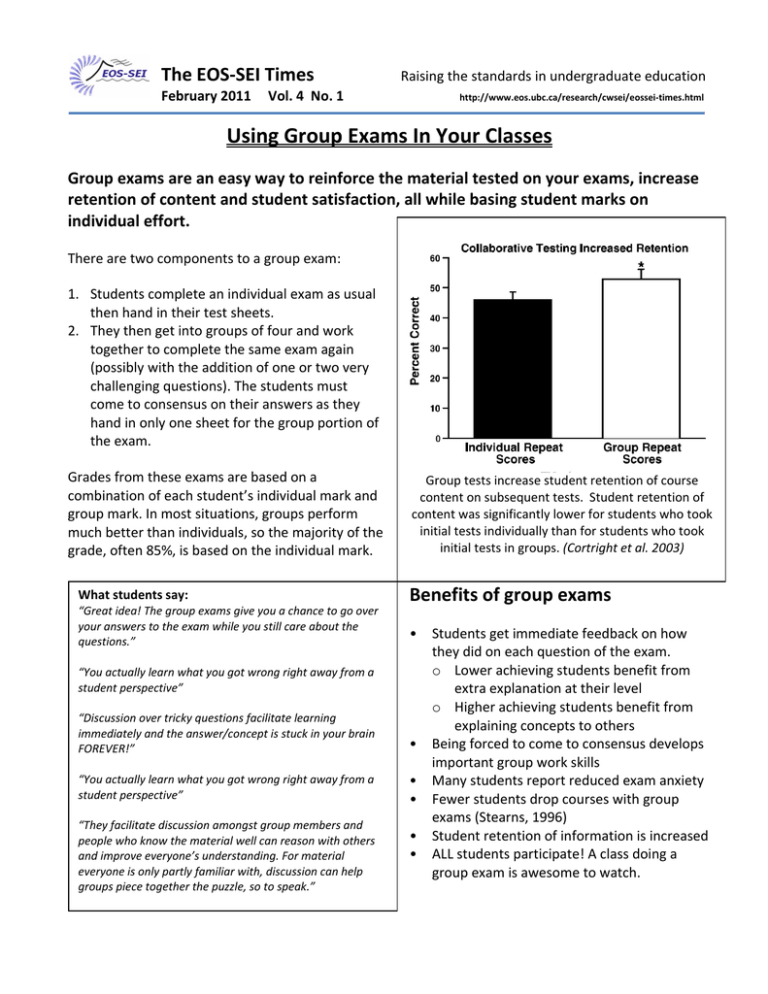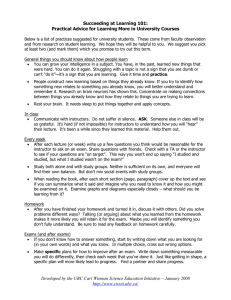Using Group Exams In Your Classes
advertisement

The EOS‐SEI Times Raising the standards in undergraduate education February 2011 Vol. 4 No. 1 http://www.eos.ubc.ca/research/cwsei/eossei‐times.html Using Group Exams In Your Classes Group exams are an easy way to reinforce the material tested on your exams, increase retention of content and student satisfaction, all while basing student marks on individual effort. There are two components to a group exam: 1. Students complete an individual exam as usual then hand in their test sheets. 2. They then get into groups of four and work together to complete the same exam again (possibly with the addition of one or two very challenging questions). The students must come to consensus on their answers as they hand in only one sheet for the group portion of the exam. Grades from these exams are based on a combination of each student’s individual mark and group mark. In most situations, groups perform much better than individuals, so the majority of the grade, often 85%, is based on the individual mark. What students say: “Great idea! The group exams give you a chance to go over your answers to the exam while you still care about the questions.” “You actually learn what you got wrong right away from a student perspective” “Discussion over tricky questions facilitate learning immediately and the answer/concept is stuck in your brain FOREVER!” “You actually learn what you got wrong right away from a student perspective” “They facilitate discussion amongst group members and people who know the material well can reason with others and improve everyone’s understanding. For material everyone is only partly familiar with, discussion can help groups piece together the puzzle, so to speak.” Group tests increase student retention of course content on subsequent tests. Student retention of content was significantly lower for students who took initial tests individually than for students who took initial tests in groups. (Cortright et al. 2003) Benefits of group exams • • • • • • Students get immediate feedback on how they did on each question of the exam. o Lower achieving students benefit from extra explanation at their level o Higher achieving students benefit from explaining concepts to others Being forced to come to consensus develops important group work skills Many students report reduced exam anxiety Fewer students drop courses with group exams (Stearns, 1996) Student retention of information is increased ALL students participate! A class doing a group exam is awesome to watch. Courses in EOS and Physics using Group Exams Course Enrol‐ ment Format Group Exam Context Grade weight Individ/Grp EOSC 111 Laboratory Exploration of Planet Earth EOSC 114 The Catastrophic Earth: Natural Disasters ATSC 201 Meteorology of Storms EOSC 211 Computer Methods in Earth, Ocean and Atmospheric Sciences EOSC 221 Intro Petrology EOSC 350 Environ, Geotech & Explor’n Geophysics I PHYS 250 Modern Phys. for Engineers 100 Lab; 20 students per lab 50 min. lecture, large class, clickers plus activities 50 min. interactive, just‐in‐time teaching. 50 min. lecture + group projects/activities Weekly reading quizzes 3 Midterms and Final 67/33 50 min lect. group activities 50 min lect. including team activities. 2hrs lecture 130‐450 100 60 80 50 60 Midterms and final 75/25 85/15 67/33 Midterm and Final 85/15 Midterms Regular quizzes; not done in exams. 2 midterms 1 final 85/15 na 75/25 A few tips for using group exams in your classes • • • • • • • • Prepare students to work in groups by using group activities during lecture Tell students before the exam about the format, why you are doing it, and how it will work Don’t lower student grades if they get a higher mark than their group on the test (this is a fairness concern for most students, but it affects very few of them. Almost all groups outperform all individuals). Make sure there is lots of time to complete both the individual portion and the group portion If possible select groups yourself, but prepare them to work together by having group activities before the exam Give very clear instructions during the individual‐to‐group transition during the exam Don’t worry if groups are speaking loudly, or listening to groups around them, cheating is much less of a concern for this type of exam Do not let students do the group portion on their own If you are interested in seeing a group exam in action or trying them in your classes contact your friendly neighbourhood STLF References: Cortright, R.N., Collins, H.L., Rodenbaugh D.W., and DiCarlo, S.T. 2003. Student retention of course content is improved by collaborative‐group testing, Advan. Physiol. Edu. 27: 102‐108 pp, 2003 Stearns, S. A. 1996. Collaborative Exams as Learning Tools College Teaching, Vol. 44, No. 3 (Summer, 1996), pp. 111‐112 Contact EOS­SEI: To talk about your course(s) or teaching and learning in general, visit EOS‐South 361, or contact Francis Jones (fjones@eos.ubc.ca), Brett Gilley (bgilley@eos.ubc.ca), Erin Lane (elane@eos.ubc.ca), Josh Caulkins (jcaulkins@eos.ubc.ca) or Sara Harris (sharris@eos.ubc.ca). See also http://www.eos.ubc.ca/research/cwsei/.

